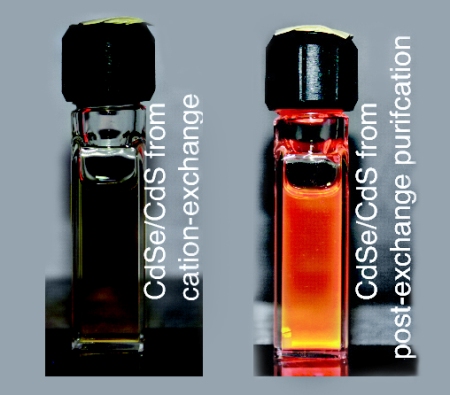A research team led by Paul Alivisatos from the Lawrence Berkeley National Laboratory (Berkeley Lab) of the U.S. Department of Energy has developed a novel solution-based synthesis method to produce nanocrystals with superior optoelectronic properties.
 Luminescence of CdSe/CuS nanocrystals prepared by cation-exchange. On the left are crystals prior to purification, on the right are the same nanocrystals after impurities have been removed. (Credit: Courtesy of Berkeley Lab)
Luminescence of CdSe/CuS nanocrystals prepared by cation-exchange. On the left are crystals prior to purification, on the right are the same nanocrystals after impurities have been removed. (Credit: Courtesy of Berkeley Lab)
The novel technique helps rectifying the issue in producing high-quality nanorods and quantum dots. The research team found that impurities in nanocrystals were made the nanomaterials a poor light emitter. These impurities are original cations that are left as residue in the lattice of the nanocrystals during the exchange process. It also showed that the removal of these impurities can be done by heating the nanomaterials.
Prashant Jain from University of Illinois stated that the research team removed the impurities through heating the nanomaterials to 100°C, thus increasing the luminescence of the nanocrystals by 400 times within 30 h. Jain added that the optoelectronic properties of the resulting nanocrystals using the cation-exchange process were analogous to that of conventionally produced nanorods and quantum dots. Jain is a former member of the team.
In the solution-based synthesis technique, nanocrystals are chemically modified by exchanging all cations found in the lattice of the crystals with another cation type. The innovative process is capable of making novel types of core/shell nanocrystals that are heterostructures wherein one semiconductor type is enfolded by another. One such example is a cadmium sulfide shell and a cadmium selenide core.
According to Alivisatos, although the novel technique is an easy and cost-effective method to fabricate multi-component nanocrystals, it has formed nanorods and quantum dots that function poorly in electronic and optical devices. Jain stated that the removal of impurities found in nanocrystals offers energetic charge-carriers sufficient time to mingle radiatively, which in turn increases luminescence.